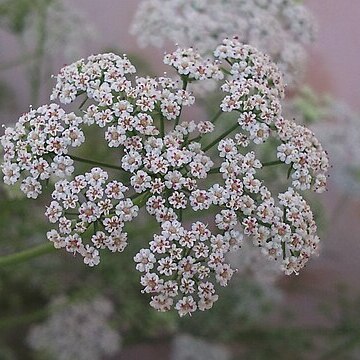Stems 25-45 cm, striate, glabrous, usually strongly branched. Leaves 2-3-pinnate, ultimate segments to 1 mm broad, narrow-oblong. Compound umbels terminal or seemingly lateral; peduncles 1-6½ cm; rays 5-9, ½-1 cm, to 2 cm in fruit; pedicels 4-15, 1-6 mm; involucres 3-5, oblong, sometimes divided; involucels 4-5, oblong; the bracts of both very unequal in length, hirsute with membranaceous margin. Calyx teeth nearly 0.2 mm, thickly subulate. Petals 0.6-0.7 mm through, obcordate with inflexed tips. Fruits to 2 by 1 mm, along the ribs with broad scale-like hairs.
Plants annual, 20–50(–90) cm, essentially glabrous. Leaves petiolate, petiole 1–5 cm; blade triangular-ovate in outline, 2–8 × 2–6 cm, 2–3-pinnate/pinnatisect; ultimate segments linear–filiform to 15 × 0.2–0.5 mm. Umbels 2.5–5 cm across; bracts 3–8, linear-subulate, 5–7 mm; rays 6–20, 1–3 cm; bracteoles 5–10, linear, 2–3 mm; umbellules ca. 1 cm across, ca. 20-flowered; pedicels 0.5–4 mm, unequal. Calyx teeth conspicuous, minute, ovate or obsolete. Petals ca. 1.3 × 1.3 mm. Fruit 1.2–2 × 1.2–1.8 mm, densely covered in whitish minute papillae. Fl. & fr. May–Aug.
A herb. It grows to 50 cm high. It is like caraway but the fruit are more rounded. It looks like parsley when growing. The leaves have stalks. Leaves are divided 2 or 3 times. The last segment is long and narrow. The flowers are white. They are in compound flat topped arrangements. The seeds form in umbrella shaped clusters. The seeds are small and tear shaped. They are light brown. There are some named cultivated varieties.

